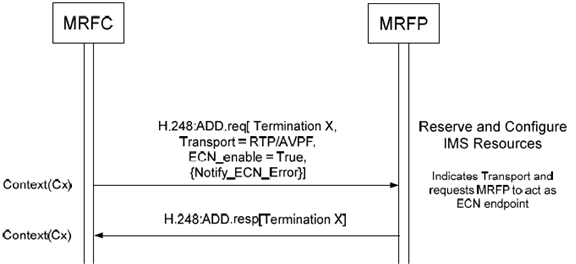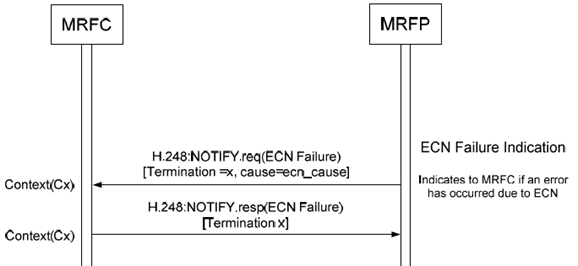Content for TS 23.333 Word version: 18.1.0
1…
4
5…
5.8…
5.12…
5.14…
5.20…
5.24…
6…
6.1.8…
6.2…
6.2.3…
6.2.4…
6.2.5
6.2.6…
6.2.7…
6.2.8…
6.2.9…
6.2.10…
6.2.10.2.7
6.2.10.3…
6.2.11…
6.2.13…
6.2.13.2.6…
6.2.14…
6.2.15…
6.2.16…
6.2.18…
6.2.19…
6.2.19.3…
6.2.20…
6.2.21…
6.2.22…
6.2.23
6.2.24…
7
8…
8.11…
8.20
8.21
8.22
8.23…
8.30…
8.39…
8.45…
8.56…
6.2.14 Explicit Congestion Notification Support
6.2.14.1 General
6.2.14.2 Message sequence chart, Request ECN
6.2.14.3 Message sequence chart, Report ECN Failure Event
...
...
6.2.14 Explicit Congestion Notification Support |R10| p. 124
6.2.14.1 General p. 124
If the MRFC receives a SDP Offer containing ECN negotiation, see RFC 6679, and the MRFC and MRFP support ECN and at least some of the initialisation methods offered within the "a=ecn-capable-rtp" attribute,
the MRFC shall:
- act as an end point for ECN;
- return a SDP Answer according to TS 26.114 and the capabilities of the MRFP, containing the "a=ecn-capable-rtp" attribute; and
- indicate to the MRFP that it shall apply the ECN procedures (according to TS 26.114) and act as an ECT endpoint.
- Initialisation = "leap";
- Mode = "setread";
- ECT Marking = ECT-0;
- Feedback is via Application Specific Adaptation Requests (i.e. Receiver Driven Congestion Control).
6.2.14.2 Message sequence chart, Request ECN p. 124
Figure 6.2.14.2.1 shows the message sequence chart example for requesting Explicit Congestion Notification.

Upon receipt of a request to apply Explicit Congestion Notification the MRFP shall set the ECN field of the IP header in accordance with TS 26.114 when sending any data packets.
Upon receipt of any IP headers indicating Congestion Experienced (ECN-CE) the MRFP shall trigger rate adaptation in accordance with TS 26.114.
6.2.14.3 Message sequence chart, Report ECN Failure Event p. 125
Figure 6.2.14.3.1 shows the message sequence chart example for ECN Failure Event.

When the MRFC receives a Notification indicating that an error has occurred it may trigger a new SDP offer to remove ECN.